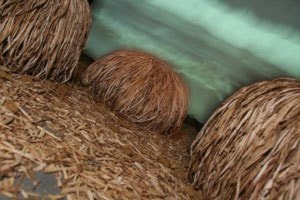Virtual waves lap at the shore in the Yukon Arts Centre.
As the tide rises and falls each crest leaves its marks on the gallery’s floor in the form of rocks, shells and garbage.
Tidal Trace, an installation that opened last week, brings the sights and sounds of the beach inside.
It’s a floor-to-ceiling multimedia collaboration between Edmonton-based artists Lyndal Osborne and John Freeman. Osborne created the objects and Freeman shot the video.
Osborne is interested in what the ocean spits out onto land, and in how those leavings vary from day to day.
But in this installation nothing is as it seems.
What look like little rocks scattered around the shore are actually teabags tied into balls and dyed brown.
The giant kelp-covered boulders are pieces of Styrofoam covered with dried day lily leaves.
And the beach grass is made from shredded paper.
“I’m using a lot of natural materials to metaphorically suggest some of the things that you might see on a beach,” says Osborne.
“And I like that artificiality. I like the fact that they might remind you of something, but they’re actually something completely different.”
She plays with the viewers who, in the dimly lit room, may not be able to tell the difference between a real rock and a Styrofoam ball covered to look like one.
“I try to use materials that are not heavy drawers from the environment,” she says. “I’m trying to use natural materials and industrial materials that are wasted.”
She shows the beauty of the beach, but doesn’t shy away from the unsightly.
Between the shells and kelp are different, unexpected objects littering beaches like broken lobster traps, shotgun shells, all kinds of plastics and tampons.
She has collected discards from beaches from British Columbia to Belfast.
The idea for Tidal Trace came together during Osborne’s 2001 artist residency in Newfoundland’s Gros Morne National Park.
“Sand between the toes, stepping gingerly over pebbles, the crackling of dry seaweed underfoot, the soothing noise of rolling surf, water lapping in the ebb and flow of tide, each wave’s retreat a sucking sound, hot sun, cumulous clouds, wind, foam, the briny smell of the salt spray in your face…,” she says as she describes her explorations of the island’s rocky shores.
The Australian-born Osborne also drew on her childhood growing up on a beach when piecing together the installation.
“As you get older you’re more influenced by your childhood than when you were younger; instead of sloughing it off you go back in your memory.
“A lot of my time was spent walking along beaches and collecting all kinds of flotsam and jetsam and bringing it home and festooning my bedroom with sponges and shells,” says Osborne.
She started making the installations before she realized it was art.
“My mother was always very proud of what I did in the bedroom and used to bring her friends in to see.
“They were kinds of mini-installations, although at the time I didn’t realize that.”
While Osborne harbours warm memories of the seaside, Freeman approached the project from a different viewpoint.
He was raised on the Southern Alberta’s prairies, and for him the beach is a dark, hazardous place.
“Southern Alberta is full of sailors, or those who want to be,” says Freeman with a laugh.
Freeman has spent long hours sailing along the coast of BC and out toward Hawaii.
“The beach is a dangerous place if you’re a sailor,” he says. “You don’t want to be near the beach, you want to be safe at sea. As you approach the shore there are all these crunchy things that want to kill you.”
Hence the inscription written on the wall before you walk into the exhibition: “He was safe at sea — it was life ashore that killed him.”
It’s a memorial to a friend who went out sailing and didn’t return.
So the installation can be taken on many levels.
It can be enjoyed as a relaxing space for reflection.
“It’s about the pleasure and contemplation that can be gained by sitting quietly and being absorbed in the sound and the smell,” says Osborne.
“When it was first exhibited in Edmonton, people would come in and just sit,” says Freeman. “And that really surprised me.”
“It’s almost like some people get a sense of loss when they look at it,” adds Osborne. “It brings back memories for them, which makes them realize there was a time in their lives when those kinds of things were important.”
But dig deeper and it’s also a metaphor for renewal.
The tide is cyclical; it rises and falls without fail, leaving its trace on the sand.
Human lives are also cyclical; we are renewed in our children and grandchildren, says Osborne.
Tidal Trace will ebb and flow at the art centre gallery until May 29.
